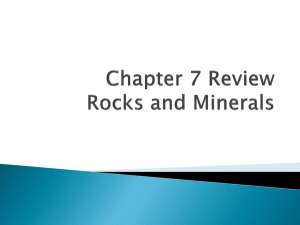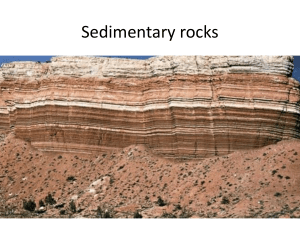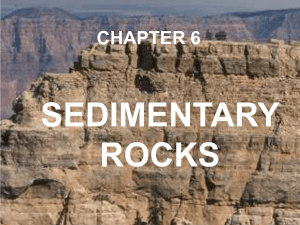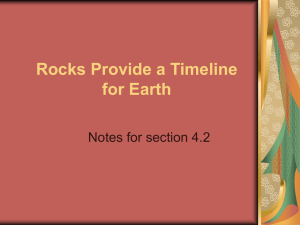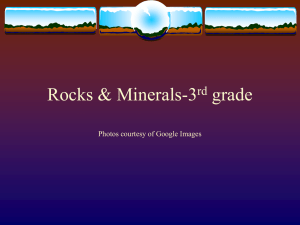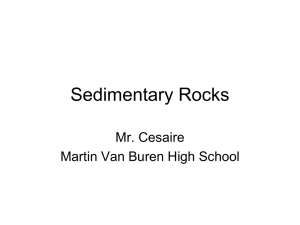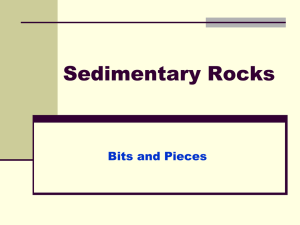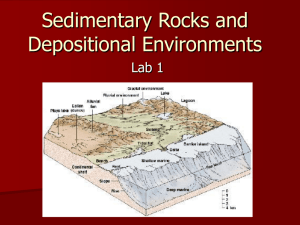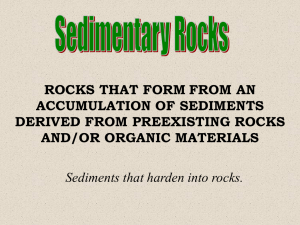Powerpoint
advertisement
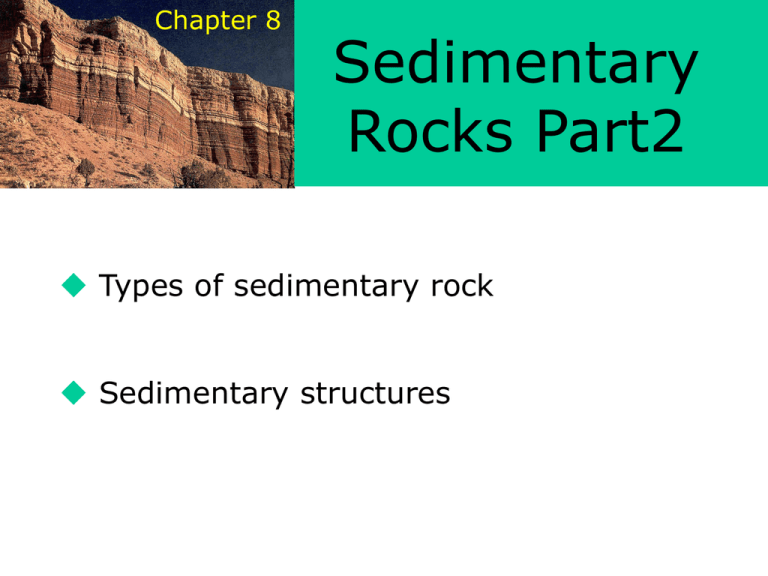
Chapter 8 Sedimentary Rocks Part2 Types of sedimentary rock Sedimentary structures Types of sedimentary rocks Sedimentary rocks • Sediment originates from mechanical and/or chemical weathering • Rock types are based on the source of the material • Clastic rocks – transported sediment as solid particles • Chemical/Biochemical rocks – sediment that was once in solution Chapter 8 Sedimentary rocks Clastic sedimentary rocks Size of clasts (particles) common name gravel size bigger than 2 mm (1/10 inch) sand silt, clay See Table 8.3 sand-sized (1/16-2) very fine-grained (<1/16) Detrital rock conglomerate or breccia sandstone shale, mudstone,siltstone sediments gravel sand silt clay sedimentary rocks conglomerate sandstone siltstone shale Chapter 8 Sedimentary rocks Clastic sedimentary rocks Siltstone, Mudstone & Shale silt & clay-sized particles (clay, silt), particles too small to identify w/ eye over 1/2 of all sedimentary rocks deposited in quiet (slow moving) water - deep ocean & continental slope - lakes - floodplains (siltstone) shale beds often underlay groundwater conduits shale may contains fossils, oily organics, breaks along bedding planes raw material for brick, tile, pottery, china shale+limestone= Portland cement Shale w/plant remains Chapter 8 Sedimentary rocks Clastic sedimentary rocks Sandstone composed of sand grains 2nd most abundant sedimentary rock deposited by moderate currents: - rivers & deltas - beaches - wind (sand dunes) mostly quartz (strong & chemically stable, but may also contain volcanic rock) See Fig. 8.15 for major groups of sandstone Chapter 8 Sedimentary rocks Clastic sedimentary rocks Sandstone sorting degree of similarity in particle size Chapter 8 Sedimentary rocks Clastic sedimentary rocks Sandstone shape degree of roundedness Chapter 8 Sedimentary rocks Clastic sedimentary rocks Conglomerate composed mostly of gravel pebbles to boulders poorly sorted deposited by strong, turbulent currents: - big flooding rivers - steep streams (near mountains) - glaciers Chapter 8 Sedimentary rocks Clastic sedimentary rocks Breccia conglomerate with angular grains didn’t travel far Chapter 8 Sedimentary rocks Chemical sedimentary rocks derived from material carried in solution to lakes/seas precipitation from solution to form “chemical sediments” 2 types of precipitation - chemical - biochemical See Table 8.4 Chapter 6 Sedimentary rocks Chemical sedimentary rocks Limestone 10% of all sedimentary rocks (by volume) most abundant chemical sedimentary rock composed primarily of calcite (calcium carbonate CaCO3) Marine biochemical limestones form as coral reefs, coquina (broken shells), and chalk (microscopic organisms) Inorganic limestones include travertine (caves) and oolitic limestone (tropical beach environment) Dolostone: dolomite=CaMg(CO3)2 Typically formed secondarily from limestone Chapter 6 Sedimentary rocks Chemical sedimentary rocks Organic rock of biochemical origin coquina (rock of shell fragments): bioclastic Chapter 6 Sedimentary rocks Chemical sedimentary rocks Fossiliferous limestone Coral reef Limestone cliff (Guadalupe Mountains Natl Park, TX) • How to build a carbonate platform See Figure story 8.16 • How to build an atoll Darwin’s theory on atolls (1831) See Box 8.1 Chapter 8 Sedimentary rocks Chemical sedimentary rocks Common chemical sedimentary rocks •Chert Made of microcrystalline silica (SiO2) Agate Varieties include flint and jasper (banded form is called agate) Chapter 8 Sedimentary rocks Chemical sedimentary rocks Evaporites water evaporates and triggers the deposition of salts sequence of precipitation: calcite (calcium carbonate), gypsum (calcium sulfate), rock salt (halite, NaCl); bitter salts (potassium and magnesium salts) (a) calcite Chapter 8 Sedimentary rocks Chemical sedimentary rocks Evaporites water evaporates and triggers the deposition of salts sequence of precipitation: carbonate, gypsum (calcium sulfate), rock salt (halite, NaCl); bitter salts (potassium and magnesium salts) ancient seawater basins evaporated and deposited salt Salt flats, Utah Death valley, Calif. Chapter 8 Sedimentary rocks Chemical sedimentary rocks Evaporites- the story of the Mediterranean During the Miocene, lower sea level almost shut down the inflow of Atlantic surface water into the Mediterranean over the Strait of Gibraltar. Evaporation removed vast quantities of water and left behind evaporative sediments that underlay the sediments in the Mediterranean today. Fig. 8.19 Chapter 8 Sedimentary rocks Chemical sedimentary rocks Coal buried and compacted plant material different kinds of coal, depending on formation process Sedimentary structures (Physical features) 1. Layers (bedding, or “strata”) 2. Cross-bedding 3. Graded beds 4. Ripple marks 5. Mud cracks Sedimentary structures (Physical features) 1. Layers (bedding, or “strata”) deposited horizontally each layer is unique separated by bedding planes Sedimentary structures (Physical features) 2. Cross-bedding tilted bedding commonly ancient sand dunes river deltas, flow channels Sedimentary structures (Physical features) 3. Graded beds particles within a layer gradually change: coarse at bottom fine at top rapid deposition from water w/ varying sed. sizes Colorado River Sedimentary structures 4. Ripple marks wavy surfaces in sand: current ripple marks tell direction of current because they are perpendicular to flow See Fig. 8.8 (Physical features) Sedimentary structures 5. Mud cracks sediment alternatively wet/dry shallow lakes, desert basins flood plains (Physical features) Some MC questions… Which of the following sets of processes is written in order of increasing temperature? A. B. C. D. sedimentation, metamorphism, diagenesis diagenesis, sedimentation, metamorphism sedimentation, diagenesis, metamorphism metamorphism, diagenesis, sedimentation Some MC questions… What type of sediments are accumulations of solid fragments produced by weathering? A. B. C. D. biochemical sediments chemical sediments clastic sediments all of the above Some MC questions… Which of the following statements about transportation of sediment is false? A. B. C. D. Smaller particles settle faster than larger particles. As a current slows, the largest particles start to settle. Faster currents carry larger particles than slower currents. Rivers and ocean currents move much more material than do air currents. Some MC questions… In what type of environment did the ripples depicted above most likely form? A. B. C. D. beach (waves) desert (wind) alluvial (stream) delta (river + tides) Some MC questions… Which of the following minerals is least likely to occur in a marine evaporite environment? A. B. C. D. calcite gypsum halite quartz
